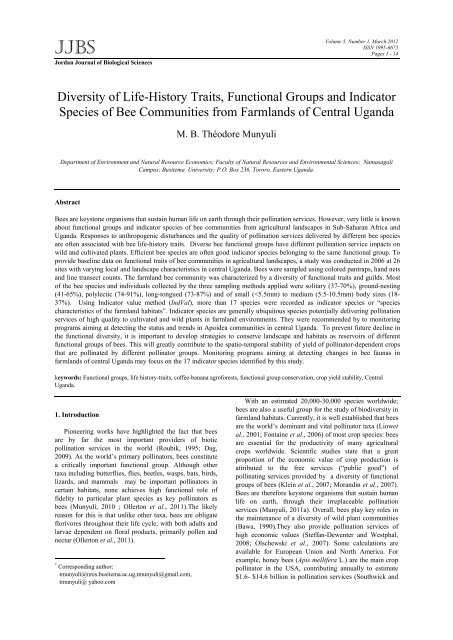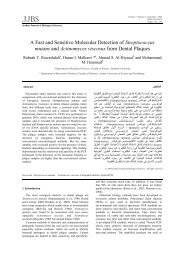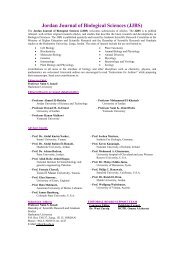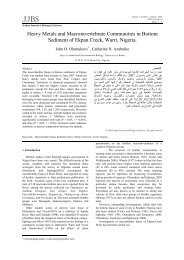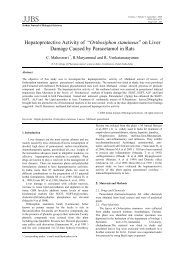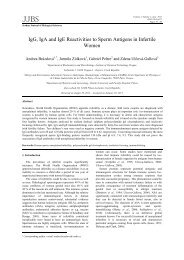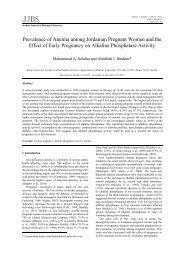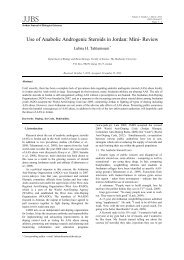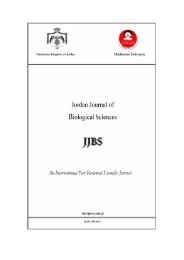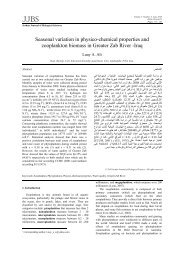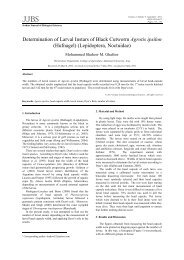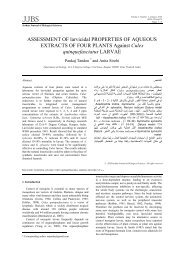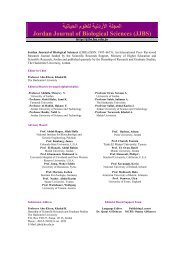Diversity of Life-History Traits, Functional Groups and Indicator ...
Diversity of Life-History Traits, Functional Groups and Indicator ...
Diversity of Life-History Traits, Functional Groups and Indicator ...
You also want an ePaper? Increase the reach of your titles
YUMPU automatically turns print PDFs into web optimized ePapers that Google loves.
JJBS<br />
Jordan Journal <strong>of</strong> Biological Sciences<br />
Volume 5, Number 1, March 2012<br />
ISSN 1995-6673<br />
Pages 1 - 14<br />
<strong>Diversity</strong> <strong>of</strong> <strong>Life</strong>-<strong>History</strong> <strong>Traits</strong>, <strong>Functional</strong> <strong>Groups</strong> <strong>and</strong> <strong>Indicator</strong><br />
Species <strong>of</strong> Bee Communities from Farml<strong>and</strong>s <strong>of</strong> Central Ug<strong>and</strong>a<br />
M. B. Théodore Munyuli<br />
Department <strong>of</strong> Environment <strong>and</strong> Natural Resource Economics; Faculty <strong>of</strong> Natural Resources <strong>and</strong> Environmental Sciences; Namasagali<br />
Campus; Busitema University; P.O. Box 236, Tororo, Eastern Ug<strong>and</strong>a.<br />
Abstract<br />
Bees are keystone organisms that sustain human life on earth through their pollination services. However, very little is known<br />
about functional groups <strong>and</strong> indicator species <strong>of</strong> bee communities from agricultural l<strong>and</strong>scapes in Sub-Saharan Africa <strong>and</strong><br />
Ug<strong>and</strong>a. Responses to anthropogenic disturbances <strong>and</strong> the quality <strong>of</strong> pollination services delivered by different bee species<br />
are <strong>of</strong>ten associated with bee life-history traits. Diverse bee functional groups have different pollination service impacts on<br />
wild <strong>and</strong> cultivated plants. Efficient bee species are <strong>of</strong>ten good indicator species belonging to the same functional group. To<br />
provide baseline data on functional traits <strong>of</strong> bee communities in agricultural l<strong>and</strong>scapes, a study was conducted in 2006 at 26<br />
sites with varying local <strong>and</strong> l<strong>and</strong>scape characteristics in central Ug<strong>and</strong>a. Bees were sampled using colored pantraps, h<strong>and</strong> nets<br />
<strong>and</strong> line transect counts. The farml<strong>and</strong> bee community was characterized by a diversity <strong>of</strong> functional traits <strong>and</strong> guilds. Most<br />
<strong>of</strong> the bee species <strong>and</strong> individuals collected by the three sampling methods applied were solitary (37-70%), ground-nesting<br />
(41-65%), polylectic (74-91%), long-tongued (73-87%) <strong>and</strong> <strong>of</strong> small (
2<br />
© 2012 Jordan Journal <strong>of</strong> Biological Sciences. All rights reserved - Volume 5, Number 1<br />
Southwick, 1992; Chamberlain <strong>and</strong> Schlisin, 2008). The<br />
economics gains from non-managed wild bees are<br />
estimated to be <strong>of</strong> US$3.07 billion per annum in USA<br />
alone (Slaa, et al., 2006; Losey <strong>and</strong> Vaughan, 2006). The<br />
ecological, agricultural <strong>and</strong> economic importance <strong>of</strong><br />
pollinators is immense (Munyuli, 2011b). The value <strong>of</strong><br />
pollination to agricultural production worldwide is<br />
currently estimated to be worth US$226 billion (€153<br />
billion) (Klein et al., 2007; Mor<strong>and</strong>in et al., 2007; Gallai et<br />
al., 2009). In Ug<strong>and</strong>a, the economic value <strong>of</strong> pollinating<br />
services delivered to the crop production sector is on<br />
average <strong>of</strong> 0.52 billion per annum (Munyuli, 2010).<br />
Despite the vital role played by bee communities in<br />
traditional agro-ecosystems, the ecological <strong>and</strong> economic<br />
importance <strong>of</strong> these organisms (Martins, 2004), the<br />
diversity <strong>of</strong> functional groups remain largely unknown <strong>and</strong><br />
un-surveyed (Eardley et al., 2009; Gordon et al., 2004) in<br />
Ug<strong>and</strong>a.<br />
There is a need to underst<strong>and</strong> functional groups <strong>and</strong><br />
indicator species <strong>of</strong> farml<strong>and</strong> bee faunas since these two<br />
types <strong>of</strong> bio-indicators can be used to monitor trends,<br />
predict <strong>and</strong> prevent degradation <strong>of</strong> bee biodiversity<br />
pollination services needed by a high number <strong>of</strong> pollinatordependent<br />
wild <strong>and</strong> cultivated plants found in rural<br />
l<strong>and</strong>scapes <strong>of</strong> Ug<strong>and</strong>a <strong>and</strong> in East Africa. Also, the<br />
knowledge <strong>of</strong> the diversity <strong>of</strong> functional groups is<br />
important to acquire since responses to anthropogenic<br />
disturbances <strong>and</strong> the quality <strong>of</strong> pollination services<br />
delivered by different bee species are <strong>of</strong>ten associated with<br />
life-history traits. Diverse functional groups <strong>of</strong> bees have<br />
different pollination service impacts on wild <strong>and</strong> cultivated<br />
plants. Efficient bee species <strong>of</strong>ten belong to the same<br />
functional group. Some wild <strong>and</strong> cultivated plant species<br />
are pollinated by bee species in the same functional group<br />
such as sharp decline in these bee groups may lead to the<br />
disappearance <strong>of</strong> plant species in strong linkage <strong>and</strong><br />
interactions with them. For example, in Ug<strong>and</strong>a, efficient<br />
pollinators <strong>of</strong> cucurbits are <strong>of</strong>ten solitary bees in the<br />
Halictini (Halictidae). Thus, cultivation <strong>of</strong> cucurbits in<br />
environments that have low Halictid bee diversity may<br />
lead to high pollination limitation <strong>and</strong> to drastic reduction<br />
<strong>of</strong> the yield (Munyuli, 2010).<br />
The diversity <strong>and</strong> incidence <strong>of</strong> different bee traits varies<br />
from a region to another. Within a region, bee species may<br />
also differ in their degree <strong>of</strong> voltinism (number <strong>of</strong><br />
generations produced within a single growing) <strong>and</strong> in their<br />
flight season (period when the bee start being active <strong>and</strong><br />
period when it ends or cease being actively seen foraging<br />
on different flowering plant species). Generally dietary<br />
specialization is associated with a higher extinction rate<br />
<strong>and</strong>/or with sensitivity to disturbance for a variety <strong>of</strong> bee<br />
taxa <strong>and</strong> functional groups. Oligolectic bee species are<br />
species known to gather pollen from a small number <strong>of</strong><br />
related flower species, whereas polylectic bees are pollen<br />
generalists. Oligolectic species probably account for a<br />
large fraction <strong>of</strong> global bee diversity, since they constitute<br />
about 30% <strong>of</strong> species in temperate communities <strong>and</strong> up to<br />
60% <strong>of</strong> species in the more species-rich desert ( Moretti et<br />
al., 2008). Cleptoparasitic bees are morphologically<br />
highly divergent from other bees. They are <strong>of</strong>ten heavily<br />
armored <strong>and</strong> lack pollen-collecting structures.<br />
Cleptoparasitic species are widespread in Apidae,<br />
Megachilidae, <strong>and</strong> Halictidae (Michener, 2007). There are<br />
only a few species <strong>of</strong> cleptoparasitic Colletidae. Overall,<br />
no cleptoparasites have been reported from Melittidae,<br />
Andrenidae <strong>and</strong> Stenotritidae bee families worldwide.<br />
Cleptoparasitism in Ug<strong>and</strong>a remains largely undocumented.<br />
It is important to know how many bee<br />
species are parasitic in a given habitat to better plan the<br />
conservation <strong>of</strong> pollination services delivered by non-<br />
parasitic bee species.<br />
In most European countries, 89% <strong>of</strong> bee species are<br />
known to be bees with narrow habitat range; whereas 10%<br />
have wide habitat range. More than 65% <strong>of</strong> European bees<br />
are univoltine (one generations per year) <strong>and</strong> less than<br />
35% <strong>of</strong> them are multivoltine (species having several<br />
generations per year) (Bismeijer et al., 2006 a <strong>and</strong> b). The<br />
degree <strong>of</strong> voltinism for afrotropical bees remains largely<br />
undescribed. Approximately, 80% <strong>of</strong> the European bee<br />
species are oligolectic bees <strong>and</strong> less than 20 % are<br />
polylectic. In the European countries, 70% <strong>of</strong> bee species<br />
are long-tongued bees <strong>and</strong> only 30% are short-tongued<br />
bees (Biesmeijer et al., 2006; Westphal et al., 2008). The<br />
proportion <strong>of</strong> long-tongued bees in Ug<strong>and</strong>a remains<br />
undescribed.<br />
The ability to predict the responses <strong>of</strong> ecological<br />
communities <strong>and</strong> individual species to human-induced<br />
environmental change remains a key issue for ecologists<br />
<strong>and</strong> conservation managers alike (Williams et al., 2010).<br />
Apoidea fauna with shared life-history <strong>and</strong> ecological<br />
traits can present variability in responses to different<br />
drivers within the same environment (Williams et al.,<br />
2010). Therefore, knowledge <strong>of</strong> range <strong>of</strong> life-history <strong>and</strong><br />
ecological traits <strong>of</strong> bee community can be used to predict<br />
bee responses to a change in a variety <strong>of</strong> disturbance types<br />
(agriculture intensification, cropping intensification,<br />
proportion <strong>of</strong> semi-natural habitats, distance to natural<br />
habitats, pesticide use, distance to natural habitats or<br />
habitat isolation, climatic factors, farm management<br />
system, grazing intensity, fire regimes, deforestation rate,<br />
etc) or drivers from a given farm-l<strong>and</strong>scape.<br />
Underst<strong>and</strong>ing the diversity <strong>of</strong> functional traits can also<br />
help in better planning conservation strategies for the<br />
protection <strong>of</strong> bees to guarantee spatio-temporal delivery <strong>of</strong><br />
pollination services to crops <strong>and</strong> wild plants. Ensuring<br />
spatio-temporal delivery <strong>of</strong> pollination services to crops is<br />
very critical for Ug<strong>and</strong>an agriculture since 78% <strong>of</strong> crop<br />
species <strong>and</strong> varieties grown by farmers in Ug<strong>and</strong>a are<br />
pollinator-dependent (Munyuli, 2011a <strong>and</strong> b).<br />
Monitoring changes in bee populations <strong>and</strong> functional<br />
traits in relationship to changes in drivers is another<br />
important step to build good conservation strategies that<br />
can reduce or prevent decline in bee species <strong>and</strong><br />
populations. Overall, underst<strong>and</strong>ing how diverse bee traits<br />
are can also help in predicting the vulnerability <strong>of</strong> plantpollinator<br />
interactions to global environmental change, to<br />
l<strong>and</strong>-use (l<strong>and</strong>-cover) changes <strong>and</strong> to various other drivers<br />
<strong>and</strong> pressures including climate change. Such knowledge<br />
can also help in better managing pollination services to<br />
meet the requirements <strong>of</strong> different plant /crop species.<br />
Some plant species can only be pollinated by certain group<br />
<strong>of</strong> bee species. The absence <strong>of</strong> such functional groups <strong>of</strong><br />
bees may lead to decline or disappearance <strong>of</strong> such<br />
specialized plant / crop species.<br />
<strong>Functional</strong> traits can be used to predict the response <strong>of</strong><br />
bee species to various drivers. <strong>Functional</strong> traits can
© 2012 Jordan Journal <strong>of</strong> Biological Sciences. All rights reserved - Volume 5, Number 1<br />
therefore be used in monitoring programs to detect trends<br />
<strong>and</strong> status <strong>of</strong> species <strong>and</strong> population in a habitat subjected<br />
to pressures <strong>of</strong> different types. <strong>Indicator</strong> species can also<br />
be used to monitor the status <strong>of</strong> a bee community in a<br />
given habitat / l<strong>and</strong>scape. If time <strong>and</strong> resource allow,<br />
monitoring the overall status <strong>of</strong> bee communities in a<br />
l<strong>and</strong>scape / habitat can simultaneously be conducted using<br />
functional traits <strong>and</strong> or indicator species information.<br />
Policy measures <strong>and</strong> conservation strategies based on both<br />
indicator species <strong>and</strong> bee functional traits are likely to be<br />
useful in the protection <strong>of</strong> most species in a<br />
l<strong>and</strong>scape/habitat (Munyuli, 2010). In addition, indicator<br />
species can help in developing effective monitoring plans<br />
<strong>of</strong> bee communities in farml<strong>and</strong> habitats <strong>of</strong> central<br />
Ug<strong>and</strong>a. Challenges related to monitoring <strong>and</strong><br />
conservation <strong>of</strong> bee faunas in farml<strong>and</strong>s <strong>of</strong> Ug<strong>and</strong>a include<br />
the absence <strong>of</strong> basic knowledge about their natural history,<br />
abundance, diversity, functional traits <strong>and</strong> in their spatiotemporal<br />
distribution in agricultural l<strong>and</strong>scapes.<br />
The objective <strong>of</strong> this study was to identify the different<br />
functional groups <strong>and</strong> indicator species <strong>of</strong> bee<br />
communities found in agricultural l<strong>and</strong>scapes in central<br />
Ug<strong>and</strong>a.<br />
In this study, it was hypothesized that farml<strong>and</strong> bee<br />
communities are not diverse in functional groups <strong>and</strong><br />
indicator species because agriculture intensification may<br />
cause the disappearance <strong>of</strong> specialized bee groups <strong>and</strong> may<br />
tend to favor few common groups. In general farml<strong>and</strong><br />
habitats are expected to support poor rich bee communities<br />
because they subjected to constant disturbances (e g crop<br />
production intensification) although studies from<br />
Kakamega Forest in Kenya (Gikungu 2006) showed that<br />
bees can be more diverse in farml<strong>and</strong> matrix habitats.<br />
2. Material <strong>and</strong> Methods<br />
2.1. Study area<br />
This study was conducted in the banana-c<strong>of</strong>fee system<br />
<strong>of</strong> Lake Victoria Arc zone, central Ug<strong>and</strong>a (Fig. 1). The<br />
study zone belongs to the Lake Victoria phytochorion with<br />
shrubs <strong>of</strong> Acacia spp, legume trees, melliferous plant<br />
species, Papyrus <strong>and</strong> palms ranging from 2 to 15m high<br />
dominating the remnant secondary vegetation. Several<br />
oily, food <strong>and</strong> cash crops are grown, mainly cassava<br />
(Manihot esculentum L.), Sweetpotato, (Ipomoea batatus,<br />
L.), maize (Zea mays), beans (Phaseolus vulgarus L.),<br />
groundnut (Arachis hypogea L.); tomato (Lycopersicon<br />
esculentum), watermelon (Citrullus lanatus), pumpkin<br />
(Cucurbita moschata), cucumber (Cucumis sativus), melon<br />
(Cucumis melo); chilies (Capsicum spp.); <strong>and</strong> several other<br />
fruits, vegetables <strong>and</strong> horticultural crops (cabbage, onion,<br />
egg plants, sim-sim, etc). The majority <strong>of</strong> these crops<br />
require different functional groups <strong>of</strong> bees to provide<br />
pollination services <strong>of</strong> high quality.<br />
This study was conducted in 26 sites selected to<br />
represent a range <strong>of</strong> habitats types with varying degrees <strong>of</strong><br />
anthropogenic disturbances <strong>and</strong> management intensities.<br />
Selected study sites were grouped into clusters using<br />
human population density as a surrogate measure <strong>of</strong><br />
agricultural intensity (Bolwig et al., 2006) <strong>and</strong><br />
anthropogenic disturbances. Each cluster comprised <strong>of</strong> 2 to<br />
4 similar sites. Detailed environmental <strong>and</strong> l<strong>and</strong>scape<br />
vegetation characteristics <strong>of</strong> the 26 sites <strong>and</strong> clusters are<br />
presented in Munyuli (2011c).<br />
2.2. Bee sampling design<br />
In each study site (1 km 2 ), five linear transects <strong>of</strong> 1000<br />
x 200 m each were set using a GPS <strong>and</strong> a tape measure.<br />
Bees were sampled on one central line transect (1000m x<br />
20m) visited on each round <strong>of</strong> data collection to obtain<br />
replicable results. Bees were sampled using three<br />
complementary methods: transect walk-<strong>and</strong>-counts (direct<br />
observations <strong>of</strong> foraging activities on flowers: visual<br />
censuses), capture using a h<strong>and</strong>net <strong>and</strong> colored pantraps<br />
following approaches described by previous workers (Potts<br />
et al, 2005; Cane,2000; Wilson et al., 2009; Banaszak <strong>and</strong><br />
Manole, 1987, 1994; Roulston et al., 2007; Droege et al.,<br />
2010; Aizen <strong>and</strong> Feinsinger, 1994)<br />
Bee specimens were sorted out <strong>and</strong> processed at<br />
Makerere University (Zoology Department Museum). All<br />
bee species were washed in 70% alcohol solution prior to<br />
pinning activities. Specimens were pinned, mounted <strong>and</strong><br />
sun-dried for three days. Preliminary identification <strong>of</strong> the<br />
bees to the family or genus level was conducted in the<br />
laboratory at Makerere University, using published<br />
dichotomous keys (Michener, 2007) <strong>and</strong> the online keys<br />
available through www.discoverlife.org (Ascher et al.,<br />
2008). Bee identifications up to species levels were further<br />
conducted at bio-systematic division <strong>of</strong> the Plant<br />
Protection Research Institute (ARC-Pretoria, South<br />
Africa), at the Natural <strong>History</strong> Museum, London (UK) <strong>and</strong><br />
at the University <strong>of</strong> Reading (UK). Another set <strong>of</strong> bee<br />
specimens (stingless bees) were sent to STRI (Smithsonian<br />
Tropical Research Institute) in Panama. The identification<br />
<strong>of</strong> bees at ARC-Pretoria was conducted under guidance <strong>of</strong><br />
Dr Connal Eardley. The identification <strong>of</strong> bee specimens at<br />
Smithsonian Tropical Research Institute was done by Dr<br />
David Roubik. The identification <strong>of</strong> bees at the natural<br />
history museum- London was conducted by Dr David<br />
Notton. A reference collection <strong>of</strong> bees <strong>of</strong> Ug<strong>and</strong>a was<br />
established <strong>and</strong> is currently housed at Makerere University<br />
Zoology Museum.<br />
2.3. Data analyses.<br />
2.3.1. Classification <strong>of</strong> bee species per functional traits<br />
<strong>and</strong> ecological characteristics<br />
Attempts were made to group all bee species recorded<br />
in this study into different functional categories in order to<br />
examine relative importance <strong>of</strong> each functional group<br />
(Moretti et al., 2009). Bee species were grouped<br />
according to taxonomic affinity <strong>and</strong> body size (Biesmeijer<br />
et al., 2006; Fontaine et al., 2006). <strong>Functional</strong> traits were<br />
obtained from the literature (Michner, 2007; Eardley <strong>and</strong><br />
Urban, 2010; Eardley et al., 2010; Eardley <strong>and</strong> Urban,<br />
2010; Roubik,1995), where available.<br />
In case, there is no information in the literature <strong>and</strong> no<br />
particular observation was conducted in the field, the trait<br />
attributes <strong>of</strong> different species were obtained from<br />
taxonomists, with experience on African bee fauna.<br />
Species which had no information on their functional traits<br />
were put in the unknown category. Overall, dietary breadth<br />
<strong>and</strong> nesting habits were determined for most species by<br />
reference to previous studies.<br />
3
4<br />
© 2012 Jordan Journal <strong>of</strong> Biological Sciences. All rights reserved - Volume 5, Number 1<br />
Figure1. Location <strong>of</strong> study sites in which the survey was conducted in the banana-c<strong>of</strong>fee growing area around Lake Victoria in Ug<strong>and</strong>a.<br />
Nesting habits <strong>of</strong> bee species for which published<br />
records were not available were inferred if all other<br />
members <strong>of</strong> the same genus or subgenus used the same<br />
nesting substrate (e.g., all nest in the ground). Only two<br />
species represented by two individuals remained<br />
ambiguous for their nesting habits <strong>and</strong> were excluded from<br />
analyses as recommended (Cane et al., 2006).<br />
The traits to which each species was categorized<br />
included:<br />
(i) Feeding specialization: (1) No lectic status (having<br />
no pollen collecting requirements; i.e. cleptoparasite), (2)<br />
Polylectic (pollen collecting on a number <strong>of</strong> species from<br />
different plant families), (3) Oligolectic (pollen collecting<br />
restricted to plants within the same plant family), (4)<br />
Monolectic (pollen collecting at a single species).<br />
(ii) Tongue length /length <strong>of</strong> the glossa /mouthparts<br />
length): (1) short tongue (2) long tongue (3) mediumtongue.<br />
(1) Short tongue (12-15mm) (Yanagizawa & Maimoni-Rodella,<br />
2007).<br />
(iii) Nesting specializations (breeding strategies): (1) no<br />
nest building, (2) excavator in the ground (miner), (3)<br />
nests in termite mounds <strong>and</strong> other ground nesters, (4)<br />
carpenter: excavator in woody substrate , (5) renter <strong>of</strong> preexisting<br />
nest <strong>and</strong> holes above the ground (cavity nesters),<br />
(6) live tree/stamp (dead wood), (7) house walls, (8) hives<br />
<strong>and</strong> (9) building nest with mud (mason bees).<br />
(iv) Parasitic status: (1) cleptoparasitic (i.e. solitary<br />
parasitic bee), (2) social parasitic, (3) non parasitic;<br />
(v)Sociality status/degree: (1) solitary: solitary, communal<br />
<strong>and</strong> semi-social; (2) social: colony founded by single<br />
individual on annual cycle (primitive eusocial) or a yearround<br />
colony (advanced eusocial); (3) variables: species is<br />
either solitary or social depending upon locality /<br />
environmental conditions (vi) Bee body length or Bee body<br />
size (mm): (1) small (21mm).<br />
The analysis <strong>of</strong> the different traits was limited to the<br />
determination <strong>of</strong> the importance (%) <strong>of</strong> each group using<br />
data from the count <strong>of</strong> number <strong>of</strong> species <strong>and</strong> individuals<br />
that fall under a given trait category.<br />
2.3.2. Species constancy <strong>and</strong> indicative value<br />
The species constancy is the proportion <strong>of</strong> sites where a<br />
given species occur permanently across sampling seasons<br />
(rounds). The species constancy provides indications about<br />
most common species in the farm-l<strong>and</strong>scape habitats.<br />
<strong>Indicator</strong> species are “ecological characteristic species”<br />
<strong>of</strong> bee communities inhabiting certain type <strong>of</strong> habitats <strong>of</strong> a<br />
given l<strong>and</strong>scape. It is important to know indicator species,<br />
particularly when interested at assessing the strength <strong>and</strong><br />
reliability <strong>of</strong> association between individual bee species<br />
<strong>and</strong> particular study sites characterized by certain l<strong>and</strong>-use,<br />
habitat, biotopes <strong>and</strong> vegetation types. <strong>Indicator</strong> species<br />
are also important <strong>and</strong> effective pollinator species <strong>of</strong> many<br />
crops <strong>and</strong> wild plant species in agricultural l<strong>and</strong>scapes
© 2012 Jordan Journal <strong>of</strong> Biological Sciences. All rights reserved - Volume 5, Number 1<br />
(Munyuli, 2010) <strong>of</strong> Ug<strong>and</strong>a. The usefulness <strong>of</strong> indicator<br />
species is that these species are easy to monitor <strong>and</strong> to<br />
sample. <strong>Indicator</strong> species are also species likely to deliver<br />
pollination services <strong>of</strong> high quality with high spatiotemporal<br />
stability (Munyuli, 2010) particularly in sub-<br />
Saharan tropical environments <strong>and</strong> in Ug<strong>and</strong>a.<br />
In this study, species constancy was calculated<br />
following the approach previously described by Banaszak<br />
(2000), d´Avila & Marchini (2008) <strong>and</strong> Silva-Pereira <strong>and</strong><br />
Santos (2006) <strong>and</strong> Lee (2002). To determine reliable <strong>and</strong><br />
stable “indicator species” or “characteristic species” in<br />
farml<strong>and</strong> habitats <strong>of</strong> central Ug<strong>and</strong>a, the indicator (IndVal)<br />
method <strong>of</strong> Dufrêne & Legendre (1997) was adopted <strong>and</strong><br />
used in this study in a modified form as recommended by<br />
Banaszak (2000) <strong>and</strong> Munyuli (2010) to identify indicator<br />
species <strong>of</strong> pollinator communities.<br />
2.4. Statistical analysis<br />
2.4.1. Variation in abundance <strong>and</strong> species richness among<br />
bee taxonomic groups.<br />
The number <strong>of</strong> bee species <strong>and</strong> individuals <strong>of</strong> different<br />
taxa were measured during the determination <strong>of</strong> the bee<br />
community structure. Statistical analyses were conducted<br />
to determine the importance <strong>of</strong> some taxa relative to<br />
others. To explore whether there were statistically<br />
significant differences in occurrences or proportional<br />
abundance / species richness between different taxonomic<br />
groups (genera, families, etc), chi-square tests in Minitab<br />
release version 15 were applied.<br />
2.4.2. <strong>Indicator</strong> species identification.<br />
Significance <strong>of</strong> the indicator value for the site with the<br />
highest indicator value was evaluated by a Chi-square test<br />
comparing the observed indicator value for a site to<br />
indicator values calculated each <strong>of</strong> the five sampling<br />
rounds conducted. Hence, Chi-square testing in Minitab 15<br />
was applied to determine the significance <strong>of</strong> the indicative<br />
value <strong>of</strong> each species across the five rounds <strong>of</strong> data<br />
collection as recommended (Banaszak, 2000; Munyuli<br />
2010).<br />
3. Results<br />
3.1. Bee biodiversity structures <strong>and</strong> composition<br />
Overall 80,883 individuals representing 652 native bee<br />
species from 6 families, 14 sub-families, 34 tribes <strong>and</strong> 79<br />
genera were captured (see species list in Munyuli, 2010;<br />
Munyuli 2011c). Up to 645 species were new records for<br />
Ug<strong>and</strong>a from the overall bee fauna diversity. There were<br />
variations in effectiveness <strong>of</strong> different sampling methods<br />
used. There was a significant (P
6<br />
© 2012 Jordan Journal <strong>of</strong> Biological Sciences. All rights reserved - Volume 5, Number 1
Species <strong>and</strong> individuals (%)<br />
80<br />
70<br />
60<br />
50<br />
40<br />
30<br />
20<br />
10<br />
0<br />
© 2012 Jordan Journal <strong>of</strong> Biological Sciences. All rights reserved - Volume 5, Number 1<br />
70.2<br />
37.2<br />
1.9<br />
47.8<br />
Figure 3. Percent (%) <strong>of</strong> species <strong>and</strong> individuals with respect to sociality/breeding strategy <strong>of</strong> different bee species collected from<br />
agricultural l<strong>and</strong>scapes <strong>of</strong> central Ug<strong>and</strong>a in 2006. (N for bee species=602; N for bee individuals= 75221)<br />
Species <strong>and</strong> individuals (%)<br />
70<br />
60<br />
50<br />
40<br />
30<br />
20<br />
10<br />
0<br />
Figure 4. Proportion (%) <strong>of</strong> species <strong>and</strong> individuals with respect to nesting strategies <strong>of</strong> different bee species collected from agricultural<br />
l<strong>and</strong>scapes <strong>of</strong> central Ug<strong>and</strong>a in 2006. (N for bee species=602; N for bee individuals= 75221)<br />
avity nesters were third most species-rich compared to<br />
house-wall nesters <strong>and</strong> hive users (honeybees) but the<br />
abundance <strong>of</strong> hive users <strong>and</strong> that <strong>of</strong> house wall nesters<br />
were greater than that <strong>of</strong> the cavity nesters (Fig.4). The<br />
nesting strategies <strong>of</strong> 4.8% <strong>of</strong> the bee species <strong>and</strong> 1.3% <strong>of</strong><br />
total individuals encountered were unknown.<br />
% Species<br />
% Abundance<br />
7.5<br />
2.1<br />
21.1<br />
13.0<br />
Solitary-bees Eusocial-bees Parasitic Unknown<br />
11.5<br />
0.22 0.18<br />
House wall<br />
nesters<br />
% Species<br />
% Abundance<br />
14.7<br />
Sociality status<br />
19.5<br />
28.6<br />
Hives Wood/pith<br />
nesters<br />
65.9<br />
41.8<br />
Groundnesters<br />
Nesting strategies<br />
9.5<br />
2.5<br />
Cavitynesters<br />
3.5. Feeding specialization <strong>and</strong> tongue length<br />
Bee individuals recorded in farml<strong>and</strong>s <strong>of</strong> central<br />
Ug<strong>and</strong>a included both oligolectic (characterized by flower<br />
constancy) <strong>and</strong> polylectic bees. Fewer specialist bees<br />
(oligolectic) occurred in farml<strong>and</strong>s <strong>of</strong> central Ug<strong>and</strong>a<br />
4.8<br />
1.3<br />
Unknwon<br />
nesting habit<br />
7
8<br />
© 2012 Jordan Journal <strong>of</strong> Biological Sciences. All rights reserved - Volume 5, Number 1<br />
compared to generalist bees (polylectic bees) (Fig.5A).<br />
Monolectic species were not recorded in this study.<br />
Four tongue-length categories characterized the<br />
farml<strong>and</strong> bee community: long-tongue, short-tongue, <strong>and</strong><br />
medium-tongue <strong>and</strong> uncertain tongue length class. There<br />
were significant differences among the tongue categories<br />
in species-rich (χ² 3df = 130.559, P
Species <strong>and</strong> individuals (%)<br />
Species <strong>and</strong> individuals (%)<br />
100<br />
90<br />
80<br />
70<br />
60<br />
50<br />
40<br />
30<br />
20<br />
10<br />
0<br />
100<br />
90<br />
80<br />
70<br />
60<br />
50<br />
40<br />
30<br />
20<br />
10<br />
0<br />
B<br />
73.0<br />
A<br />
© 2012 Jordan Journal <strong>of</strong> Biological Sciences. All rights reserved - Volume 5, Number 1<br />
87.6<br />
% Species<br />
% Abundances<br />
8.9<br />
25.7<br />
91.1<br />
Oligolectic Polylectic<br />
Food specialization categories <strong>of</strong> bees<br />
21.6<br />
9.5<br />
% Species<br />
% Abundance<br />
Long-tongued Short-tongued Medium<br />
tongued<br />
Tongue length categories<br />
74.3<br />
3.2 1.9 2.8 1.2<br />
Uncertain<br />
Figure 5. Percentage (%) <strong>of</strong> bee species <strong>and</strong> individuals captured in agricultural l<strong>and</strong>scapes <strong>of</strong> central Ug<strong>and</strong>a with respect to (A)<br />
floral specificity (oligolectic: pollen-gather specialists, polylectic: pollen-gather generalists) <strong>and</strong> (B) proboscis or tongue length<br />
(feeding strategy= feeding ability index) <strong>of</strong> bees collected in farml<strong>and</strong>s <strong>of</strong> central Ug<strong>and</strong>a in 2006. N for bee species=602; N for<br />
bee individuals= 75221.<br />
9
10<br />
Body size (mm) classes<br />
Unknown bees size<br />
Very large body<br />
sized bees (>21 mm)<br />
Large body sized<br />
bees ( 15.5-20.5mm)<br />
Medium body sized<br />
bees (10.5-15.5 mm)<br />
Small body sized<br />
bees (5.5-10.5 mm)<br />
Very small body<br />
size bees (7-12mm) solitary bee species (best<br />
represented by Anthophorinae) were the dominant bee<br />
categories followed by bees <strong>of</strong> intermediate glossa (3-<br />
6.9mm) <strong>and</strong> by the category <strong>of</strong> short tongued bees or bees<br />
with short bilobate (
© 2012 Jordan Journal <strong>of</strong> Biological Sciences. All rights reserved - Volume 5, Number 1<br />
Table-1: Sites <strong>of</strong> permanent occurrence (SPO), species constancy (SC) <strong>and</strong> species indicative value (IDV) <strong>of</strong> bee community, from the<br />
c<strong>of</strong>fee-banana-farml<strong>and</strong>s <strong>of</strong> central Ug<strong>and</strong>a during year 2006.<br />
Bee species SPO SC(%) MIDV(%) Bee species SPO S C(%) MIDV(%) Bee species SPO S C(%) MIDV(%)<br />
Apis mellifera adansonii 26 100 96.25 * M eliponula boc<strong>and</strong>ei 4 15.4 0.17 ns Pachymelus sp. 2 7.9 0.034 ns<br />
Hypotrigona gribodoi 22 84.6 81.42 ** Nomia scutellaris 7 26.9 0.28 ns Pasites jenseni 2 7.7 0.033 ns<br />
Axestotrigona ferruginea 22 84.6 70.92 ** Patellapis alb<strong>of</strong>asciata 8 30.8 0.03 ns Liotrigona sp. 4 15.4 0.028 ns<br />
Lasioglossum sp.1 17 65.4 44.51 ** Ceratina rufigastra 15 57.7 0.10 ns Ctenoplectra s p.2 10 38.5 0.024 ns<br />
Halictus sp.1 26 100 42.71 ** Pachyanthidium bicolor 9 34.6 0.03 ns Coelioxys torridula 4 15.4 0.023 ns<br />
Apis mellifera scutellata 22 84.6 40.19 ** Ceratina lineola 20 76.9 2.51 ns Cleptotrigona cubiceps 6 23.1 0.023 ns<br />
Lipotriches sp.1 25 96.2 23.78 * Patellapis (Zonalictus) sp.1 13 50.0 0.08 ns Tetraloniella sp. 3 11.5 0.020 ns<br />
Lasioglossum kampalense 24 92.3 17.92 * Lasioglossum(Ctenonomia) duponti 6 23.1 0.02 ns Scrapter nitidus 8 30.8 0.020 ns<br />
Ceratina sp.1 22 84.6 14.39 * M egachile gratiosa 7 26.9 0.02 ns Colletes sp.1 4 15.4 0.020 ns<br />
Braunsapis angolensis 21 80.8 12.87 * M elitturga penirithorum 12 46.2 1.29 ns Lithurge sp. 3 11.5 0.019 ns<br />
Heriades sp.1 23 88.5 12.49 * Hylaeus braunsi 11 42.3 0.10 ns Lasioglossum sp.3 4 15.4 0.018 ns<br />
Allodapula sp. 22 84.6 8.19 ns Braunsapis sp. 2 7.7 0.10 ns Lipotriches dom inarum 9 34.6 0.018 ns<br />
Halictus jucundus 24 92.3 17.51 * Halictus frontalis 8 30.8 0.09 ns Amegilla acraensis 7 26.9 0.018 ns<br />
Allodape sp. 23 88.5 14.66 * Compsomelissa nigrinervis 16 61.5 1.49 ns Anthidium strigatum 2 7.7 0.016 ns<br />
Lasioglossum sp.2 23 88.5 13.85 * N om ia granulata 4 15.4 0.09 ns Lasioglossum sp.4 7 26.9 0.015 ns<br />
Meliturgula sp. 22 84.6 2.57 ns Pachymelus sp.1 7 26.9 1.85 ns Dactylurina schmidti 6 23.1 0.015 ns<br />
Plebeina hildebr<strong>and</strong>ti 8 30.8 2.19 ns Halictus sp.2 21 80.8 0.43 ns Melitta arrogans 2 7.7 0.015 ns<br />
Ctenoplectra sp.1 13 50.0 1.52 ns Anthophora sp. 11 42.3 0.07 ns Ctenoplectra politula 4 15.4 0.015 ns<br />
Apotrigona nebulata 20 76.9 15.54 * Scrapter flavostictus 2 7.7 0.07 ns Megachile sp.2 7 26.9 0.014 ns<br />
Ceratina sp.2 15 57.7 1.42 ns Othinosmia globicola 12 46.2 0.06 ns Xylocopa inconstans 18 69.2 0.012 ns<br />
Lipotriches sp.1 12 46.2 1.12 ns Halterpis nigrinervis 11 42.3 0.06 ns Andrena sp. 4 15.4 0.012 ns<br />
Plebeilla lendliana 9 34.6 1.12 ns Patellapis sp.1 3 11.5 0.05 ns Hylaeus ug<strong>and</strong>icus 5 19.2 0.011 ns<br />
Nomia atripes 24 92.3 13.13 * Patellapis dispostia 2 7.7 0.05 ns Megachile fimbriata 2 7.7 0.011 ns<br />
Ceratina tanganyicensis 15 57.7 12.99 * Braunsapis fascialis 7 26.9 0.05 ns Braunsapis bouyssoui 5 19.2 0.011 ns<br />
Allodapula acutigera 18 69.0 16.89 * Ctenoplectra polita 9 34.6 0.04 ns Thyreus sp. 2 7.7 0.006 ns<br />
Xylocopa caffra 17 65.4 0.35 ns Coelioxys natalensis 6 23.1 0.03 ns Hoplitis sp. 3 11.5 0.006 ns<br />
Lipotriches sp.3 14 53.8 0.23 ns Pseudanthidium sp. 10 38.5 0.03 ns Tetralonia (Eucara) sp. 2 7.7 0.007 ns<br />
Significant:* =P
12<br />
© 2012 Jordan Journal <strong>of</strong> Biological Sciences. All rights reserved - Volume 5, Number 1<br />
their emergence to the bloom <strong>of</strong> their host plant species<br />
better than polylectic species. Because both polylectic <strong>and</strong><br />
oligolectic bees play distinct important roles in the<br />
maintenance <strong>of</strong> wild <strong>and</strong> cultivated plant species in Sub-<br />
Sahara Africa (Munyuli, 2010); hence they are<br />
irreplaceable by generalist bees in some countries in Sub-<br />
Sahara Africa <strong>and</strong> in neotropical regions like in Brazil. The<br />
conservation <strong>of</strong> oligolectic in l<strong>and</strong>scape may therefore<br />
appear imperative (Buschini et al., 2009) particularly in<br />
sites where they are the leading pollinators <strong>of</strong> some plants<br />
<strong>and</strong> crops.<br />
In farml<strong>and</strong>s <strong>of</strong> central Ug<strong>and</strong>a, two bee body size<br />
classes dominated the bee community: the class <strong>of</strong> 5-<br />
10mm followed by that <strong>of</strong> 10-15mm body size. Similarly,<br />
in an agricultural l<strong>and</strong>scape in the state <strong>of</strong> São Paulo<br />
(Brazil), it was observed that 5-10mm (49%) body size <strong>and</strong><br />
10-15mm (35%) body size classes dominated the farml<strong>and</strong><br />
bee communities (Souza <strong>and</strong> Campos, 2008). Generally,<br />
there is a strong linkage between bee body size (mm) <strong>and</strong><br />
their foraging distance <strong>and</strong> bee foraging distance affects<br />
agricultural production (Greenleaf et al., 2007). Foraging<br />
distance determines the spatial scale at which different<br />
group <strong>of</strong> wild bees can provide pollination services to<br />
crops. Animal pollination is required to produce 30% <strong>of</strong><br />
the world foods (Klein et al., 2007; Greenleaf et al., 2007).<br />
It can be expected that functional groups <strong>of</strong> wild bees that<br />
pollinate crops nest in natural habitats <strong>and</strong> forage on crops<br />
within their daily travel distance that is related to their<br />
body size (Greenleaf et al., 2007).<br />
In addition larger species travel over larger distances<br />
(>2000-3000m) than do smaller species (250-1000m) for<br />
the spatial exploitation <strong>of</strong> food resources available at<br />
different scales <strong>of</strong> the l<strong>and</strong>scape (Westphal et al., 2008).<br />
Although small <strong>and</strong> medium sized bee species dominated<br />
central Ug<strong>and</strong>a farml<strong>and</strong> bee community; unfortunately,<br />
the majority <strong>of</strong> crop species grown are pollinated by tiny,<br />
small <strong>and</strong> medium bees (Munyuli, 2011c). Hence, the need<br />
<strong>of</strong> growing pollinator-dependent crop species in the<br />
foraging range <strong>of</strong> their pollinators, or alternatively<br />
managing conservation <strong>of</strong> habitats nearby farms to attract<br />
effective pollinators to nest in the vicinity <strong>of</strong> fields.<br />
Much as it is not always easy to predict extinction risk<br />
<strong>and</strong> sensitivity to disturbance <strong>of</strong> different bee species<br />
based on body size data; l<strong>and</strong>scape-wide availability <strong>of</strong><br />
different resources (mass flowering crops <strong>and</strong> semi-natural<br />
habitats) should be considered by farms <strong>and</strong> l<strong>and</strong>scape<br />
managers to maintain a variety <strong>of</strong> functional groups <strong>of</strong><br />
bees in the proximity <strong>of</strong> cultivated crop species.<br />
5. Conclusion <strong>and</strong> Recommendations<br />
In this study, it was found that farml<strong>and</strong>s support a rich<br />
bee fauna comprising <strong>of</strong> over 600 species belonging to<br />
several tribes, families, genera <strong>and</strong> functional guilds. The<br />
study highlighted species that should be currently<br />
characterize the bee fauna pollinating crops in central<br />
Ug<strong>and</strong>a <strong>and</strong> could be monitored to detect potential decline<br />
in bee species in the farml<strong>and</strong> <strong>of</strong> Ug<strong>and</strong>a when aiming at<br />
preventing total loss <strong>of</strong> species due to anthropogenic<br />
factors. Strategies to prevent future decline (driven by<br />
anthropogenic <strong>and</strong> climate change factors) in species<br />
richness <strong>and</strong> in different functional traits are therefore<br />
outlined below. Making farml<strong>and</strong> more suitable for<br />
different functional groups <strong>of</strong> bees can benefits both<br />
agriculture <strong>and</strong> nature conservation (Carvalheiro et al.,<br />
2010). In Sub-Sahara <strong>and</strong> in East Africa, there exist few<br />
studies <strong>of</strong> bee communities in rural l<strong>and</strong>scapes (Gikungu,<br />
2006; Kajobe, 2008).<br />
This study focused on the characterization <strong>of</strong><br />
agricultural bee fauna (functional groups) in central<br />
Ug<strong>and</strong>a. This is the first solid contribution to the study <strong>of</strong><br />
bee faunas from farml<strong>and</strong>s in Ug<strong>and</strong>a. There has been no<br />
previous extensive study highlighting the diversity <strong>of</strong> bee<br />
functional traits occurring in the region. It is therefore<br />
believed that this study will form a basis for further studies<br />
in other countries <strong>of</strong> Sub-Sahara Africa with similar<br />
environmental characteristics in order to develop <strong>and</strong> set<br />
proper monitoring <strong>and</strong> conservation strategies <strong>of</strong><br />
pollination services delivered by functionally diverse bee<br />
communities.<br />
Acknowledgements<br />
I am very grateful to Darwin Initiative (Defra, UK;<br />
project reference: 14-032; project title: Conserving<br />
biodiversity in modernized farm l<strong>and</strong>scapes in Ug<strong>and</strong>a) for<br />
funding this study. I am also very grateful to Dr Simon<br />
Potts (University <strong>of</strong> Reading), Pr<strong>of</strong> Philip Nyeko<br />
(Makerere University, Ug<strong>and</strong>a), Dr Juliet Vickery (RSPB-<br />
Cambridge University, UK), Pr<strong>of</strong> Derek Pomeroy<br />
(Makerere University) <strong>and</strong> to Dr Phil Atkinson( British<br />
Trust for Ornithology) for various kind <strong>of</strong> financial <strong>and</strong><br />
scientific supports <strong>of</strong>fered to me. I am also very grateful to<br />
taxonomists: Dr Connal Eardley (from the biosystematic<br />
division <strong>of</strong> ARC-PPRI, RSA), Dr. David Notton (curator,<br />
hymenoptera section, natural history museum, London),<br />
Dr David Roubik (from Smithsonian Tropical Research<br />
Institute-Panama) <strong>and</strong> to Mr. Stuart Roberts (from the<br />
University <strong>of</strong> Reading in the UK).<br />
References<br />
Aizen M A <strong>and</strong> Feinsinger P.1994. Habitat fragmentation, native<br />
insect pollinators, <strong>and</strong> feral honey-bees in Argentine Chaco<br />
Serrano. Ecological Applications, 4(2): 378–392.<br />
Ascher J, Eardley C, Griswold T, Melo G, Polaszek A, Ruggiero<br />
M, Williams P, Walker K <strong>and</strong> WarritN.2008. World Bee<br />
Checklist Project – update 2008-09, manuscript (version<br />
10/09/2008), [online] Integrated Taxonomic Information System.<br />
http://www.itis.gov/ beechecklist.html (accessed on: 29 August<br />
2009).<br />
Banaszak J <strong>and</strong> Manole T. 1994. <strong>Diversity</strong> <strong>and</strong> density <strong>of</strong><br />
pollinating insects(Apoidea) in the agricultural l<strong>and</strong>scape <strong>of</strong><br />
Rumania. Polskie Pismo Entomologiczne, 57:747-766.<br />
Banaszak J. 2000.Pollinating insects (Apoidea) from “Puszcza<br />
Zielonka” L<strong>and</strong>scape Park, Pol<strong>and</strong>. In: Banaszak (editor),<br />
Ecology <strong>of</strong> Forest Isl<strong>and</strong>s. p:108-134. Bydgoszcz University<br />
press 2000.<br />
Bawa R.1990. Plant-pollinator interactions in tropical rain forests.<br />
Annu. Rev. Ecol. Syst, 21:399-422.<br />
Biesmeijer JC <strong>and</strong> Slaa EJ 2006b.The structure <strong>of</strong> Eusocial bee<br />
assemblages in Brazil. Apidologie, 37: 240–258.
© 2012 Jordan Journal <strong>of</strong> Biological Sciences. All rights reserved - Volume 5, Number 1<br />
Biesmeijer JC, Roberts SPM, Reemer M, Ohlemuller, R, Edwards<br />
M, Peeters T, Schaffer AP, Potts SG, Kleukers R, Thomas CD,<br />
Settele J <strong>and</strong> Kunin WE. 2006a. Parallel declines in Pollinators<br />
<strong>and</strong> insect-pollinated plants In Britain <strong>and</strong> the Netherl<strong>and</strong>s.<br />
Science, 313: 351-354.<br />
Brosi JB, Daily GC <strong>and</strong> Ehrlich PR. 2007. Bee community shifts<br />
with l<strong>and</strong>scape context in a tropical countryside. Ecological<br />
Applications, 17(2): 418–430.<br />
Buschini MLT, Rigon J <strong>and</strong> Cordeiro J. 2009. Plants used by<br />
Megachile (Moureapis) sp. (Hymenoptera: Megachilidae) in the<br />
provisioning <strong>of</strong> their nests. Brazilian J <strong>of</strong> Biol., 69(4): 1187-1194.<br />
Byarugaba D. 2004.Stingless bees (Hymenoptera: Apidae) <strong>of</strong><br />
Bwindi impenetrable forest, Ug<strong>and</strong>a <strong>and</strong> Abay<strong>and</strong>a indigenous<br />
knowledge. Inter J <strong>of</strong> Tropical Insect Science, 24(1):117–121.<br />
Cane JH, Minckley RL. <strong>and</strong> Kervin L.2000. Sampling bees<br />
(Hymenoptera: Apiformes) for pollinator community studies:<br />
pitfalls <strong>of</strong> pan-trapping. J <strong>of</strong> the Kansas Entomol Society, 73:225–<br />
231.<br />
Cane JH, Minckley RL, Kervin LJ, Roulston TH. <strong>and</strong> Williams<br />
NM. 2006. Complex responses within a desert bee guild<br />
(Hymenoptera: Apiformes) to urban habitat fragmentation.<br />
Ecological Applications, 16 (2): 632–644.<br />
Carvalheiro LG, Veldtman R, Shenkute RG, Tesfay GB, Walter<br />
C, Pirk W, Donaldson JS <strong>and</strong> Nicolson, SW. 2011. Natural <strong>and</strong><br />
within-farml<strong>and</strong> biodiversity enhances crop productivity. Ecology<br />
Letters, 14: 251–259.<br />
Chamberlain SA <strong>and</strong> Schlising RA. 2008. Role <strong>of</strong> Honey Bees<br />
(Hymenoptera: Apidae) in the Pollination Biology <strong>of</strong> a California<br />
Native Plant, Triteleialaxa (Asparagales: Themidaceae).Environ<br />
Entomol., 37(3): 808-816.<br />
d´Avila M <strong>and</strong> Marchini LC 2008.Faunistic analysis <strong>of</strong> flowervisiting<br />
hymenoptera in Cerradã<strong>of</strong>ragment .Ciência Florestal<br />
Santa Maria,18 (2): 271-279.<br />
Dag A. 2009. Interaction between pollinators <strong>and</strong> crop plants: The<br />
Israeli experience. Israel J <strong>of</strong> Plant Sciences, 57(3): 231–242.<br />
De Albuquerque P MC, de Camargo JMF. <strong>and</strong> Mendonça<br />
JMC.2007. Bee community <strong>of</strong> a beach dune ecosystem on<br />
Maranhão Isl<strong>and</strong>, Brazil. Brazilian Archives <strong>of</strong> Biol <strong>and</strong><br />
Technol.,50 (6):1005-1018.<br />
Droege S, Tepedino VJ, Lebuhn G, Link W, Minckley RL, Chen<br />
Q. <strong>and</strong> Conrad C. 2010. Spatial patterns <strong>of</strong> bee captures in North<br />
American bowl trapping surveys. Insect Conservation <strong>and</strong><br />
<strong>Diversity</strong>, 3: 15–23.<br />
Eardley C. <strong>and</strong> Urban R. 2010. Catalogue <strong>of</strong> Afrotropical bees<br />
(Hymenoptera: Apoidea: Apiformes).Zootaxa, 2455: 1–548.<br />
Eardley C, Kuhlmann M. <strong>and</strong> Pauly A 2010. The Bee Genera <strong>and</strong><br />
Subgenera <strong>of</strong> sub-Saharan Africa, AbcTaza, 7: 1-145.<br />
Eardley CD, Gikungu M. <strong>and</strong> Schwarz MP 2009. Bee<br />
conservation in Sub-Saharan Africa <strong>and</strong> Madagascar: diversity,<br />
status <strong>and</strong> threats. Apidologie, 40: 355–366.<br />
Fontaine C, Dajoz I, Meriguet J. <strong>and</strong> Loreau M. 2006.<strong>Functional</strong><br />
diversity <strong>of</strong> plant–pollinator interaction webs enhances the<br />
persistence <strong>of</strong> plant communities. PLoS Biology, 4(1): e1. ( DOI:<br />
10.1371/journal.pbio.0040001).<br />
Gallai N, Salles JM., Settele J <strong>and</strong> Vaissière B.E 2009. Economic<br />
valuation <strong>of</strong> the vulnerability <strong>of</strong> world agriculture confronted with<br />
pollinator decline. Ecological Economics 68: 810-821.<br />
Gikungu MW.2006. Bee diversity <strong>and</strong> some aspects <strong>of</strong> their<br />
ecological interactions with plants in a successional tropical<br />
community. Dissertation, University <strong>of</strong> Bonn, 201p.<br />
Gordon JR, Balkwill K. <strong>and</strong> Gemmill B. 2004. African pollination<br />
studies: where are the gaps? Inter J <strong>of</strong> Tropical Insect Science, 24<br />
(1): 5–28.<br />
Greenleaf SS, Williams NM, Winfree R <strong>and</strong> Kremen C.2007.Bee<br />
foraging ranges <strong>and</strong> their relationship to body size. Oecologia,<br />
153:589–596.<br />
Grundel R, Jean RP, Frohnapple KJ, Glowacki GA, Scott PE. <strong>and</strong><br />
Pavlovic NB. 2010. Floral <strong>and</strong> nesting resources, habitat structure,<br />
<strong>and</strong> fire influence bee distribution across an open-forest gradient.<br />
Ecological Applications, 20(6):1678–1692.<br />
Kajobe R. 2008. Foraging behaviour <strong>of</strong> equatorial Afro-tropical<br />
stingless bees: Habitat selection <strong>and</strong> competition for resources.<br />
PhD thesis, University <strong>of</strong> Utrecht, Netherl<strong>and</strong>s, 128pp.<br />
Klein A-M, Vaissiere BE, Cane, JH, Steffan-Dewenter I,<br />
Cunningham SA, Kremen C. <strong>and</strong> Tscharntke T. 2007. Importance<br />
<strong>of</strong> pollinators in changing l<strong>and</strong>scapes for world crops.<br />
Proceedings <strong>of</strong> Royal Society <strong>of</strong> London. B.,274: 303–313.<br />
Lee RA.2002. Interactive design <strong>of</strong> farm conversion. Linking<br />
agricultural research <strong>and</strong> farmer learning for sustainable small<br />
scale horticulture production in Colombia. PhD Thesis,<br />
Wageningen University, Wageningen, The Netherl<strong>and</strong>s , 294pp;<br />
ISBN: 90-5808-7492.<br />
Liow LH, Sodhi NS. <strong>and</strong> Elmqvist T. 2001.Bee diversity along a<br />
disturbance gradient in tropical lowl<strong>and</strong> forests <strong>of</strong> south-east Asia.<br />
J <strong>of</strong> Applied Ecol., 38: 180-192.<br />
Losey J E. <strong>and</strong> Vaughan M. 2006. The economic value <strong>of</strong><br />
ecological services provided by insects. BioScience,56: 311–323.<br />
Martins DJ.2004. Foraging patterns <strong>of</strong> managed honeybees <strong>and</strong><br />
wild bee species in an arid African environment: ecology,<br />
biodiversity <strong>and</strong> competition. Inter J <strong>of</strong> Tropical Insect Science,<br />
24(1):105–115.<br />
Meléndez-Ramirez V, Magaña-Rueda S, Parra-Tabla V, Ayala R.<br />
<strong>and</strong> Navarro J. 2002. <strong>Diversity</strong> <strong>of</strong> native bee visitors <strong>of</strong> cucurbit<br />
crops (Cucurbitaceae) in Yucatán, México. J <strong>of</strong> Insect<br />
Conservation, 6: 135–147.<br />
Michener CD.2007. The Bees <strong>of</strong> the World, the John Hopkins<br />
University Press, Baltimore <strong>and</strong> London, pp 913.<br />
Minckley R. 2008. Faunal composition <strong>and</strong> species richness<br />
differences <strong>of</strong> bees (Hymenoptera: Apiformes) from two north<br />
American regions. Apidologie, 39: 176–188.<br />
Mor<strong>and</strong>in LA, Winston ML, Abbott VA <strong>and</strong> Franklin MT. 2007.<br />
Can pasturel<strong>and</strong> increase wild bee abundance in agriculturally<br />
intense areas? Basic <strong>and</strong> Applied Ecol., 8: 117—124.<br />
Moretti M, de Bello F, Roberts SPM <strong>and</strong> Potts SG. 2009.<br />
Taxonomical vs. functional responses <strong>of</strong> bee communities to fire<br />
in two contrasting climatic regions. J <strong>of</strong> Animal Ecol., 78: 98–108.<br />
13
14<br />
© 2012 Jordan Journal <strong>of</strong> Biological Sciences. All rights reserved - Volume 5, Number 1<br />
Moroń D, Szentgyörgyi H, Wantuch M, Celary W, Westphal C,<br />
Settele J <strong>and</strong> Woyciechowski M. 2008. <strong>Diversity</strong> <strong>of</strong> wild bees in<br />
wet meadows: implications for conservation. Wetl<strong>and</strong>s, 28 (4):<br />
975–983.<br />
Munyuli TMB. 2010. Pollinator biodiversity <strong>and</strong> economic value<br />
<strong>of</strong> pollination services in Ug<strong>and</strong>a (PhD Dissertation), Kampala,<br />
Ug<strong>and</strong>a, 431 pages: Makerere University.<br />
Munyuli TMB. 2011a. Farmers’ perception <strong>of</strong> pollinators in<br />
c<strong>of</strong>fee production in Ug<strong>and</strong>a. Agricultural Sciences, 2 (3): 318-<br />
333.<br />
Munyuli TMB. 2011b. Factors governing flower visitation<br />
patterns <strong>and</strong> quality <strong>of</strong> pollination services delivered by social <strong>and</strong><br />
solitary bee species to c<strong>of</strong>fee in central Ug<strong>and</strong>a. African J <strong>of</strong><br />
Ecol., (In press) (doi: 10.1111/j.1365-2028.2011.01284.x).<br />
Munyuli TMB. 2011c. Pollinator biodiversity in Ug<strong>and</strong>a <strong>and</strong> in<br />
Sub-Sahara Africa: L<strong>and</strong>scape <strong>and</strong> habitat management strategies<br />
for its conservation. Inter J <strong>of</strong> Biodiversity <strong>and</strong> Conservation<br />
(Inpress).<br />
Norden BB. 2008. A Checklist <strong>of</strong> the bees (Insecta: Hymenoptera)<br />
<strong>and</strong> their floral hosts at Plummers Isl<strong>and</strong>, Maryl<strong>and</strong>. Bulletin <strong>of</strong><br />
the Biol Society <strong>of</strong> Washington, 15:168-172.<br />
Olschewski R, Tscharntke T, Benítez BC, Schwarze S <strong>and</strong> Klein<br />
A-M. 2007. Economic evaluation <strong>of</strong> ecosystem services as a basis<br />
for stabilizing rainforest margins? In: T. Tscharntke et al.( Eds),<br />
The Stability <strong>of</strong> Tropical Rainforest Margins: Linking<br />
Ecological, Economic <strong>and</strong> Social Constraints <strong>of</strong> L<strong>and</strong> Use <strong>and</strong><br />
Conservation. Edited by T. Tscharntke et al. Environmental<br />
Science Series. Berlin: Springer. 265–278.<br />
Ollerton J, Winfree R <strong>and</strong> Tarrant S. 2011. How many flowering<br />
plants are pollinated by animals? Oikos, 120: 321–326.<br />
Potts SG, KevanPG <strong>and</strong> Boone JW.2005.Conservation in<br />
Pollination: Collecting, surveying <strong>and</strong> monitoring. In: Dafni A<br />
<strong>and</strong> Kevan P (Eds.), Pollination Ecology: A Practical<br />
Approach, Enviroquest, Cambridge, Canada.<br />
Roubik D W .1995.Pollination <strong>of</strong> Cultivated Plants in the<br />
Tropics. FAO, Rome.,198pages.<br />
Roulston T H, Smith SA <strong>and</strong> Brewster AL2007. A comparison <strong>of</strong><br />
pan trap <strong>and</strong> intensive net sampling techniques for documenting a<br />
bee (Hymenoptera: Apiformes) fauna. J <strong>of</strong> the Kansas Entomol<br />
Society, 80:179-181.<br />
Schlindwein C. 1998. Frequent oligolecty characterizing a diverse<br />
bee–plant community in a xerophytic bushl<strong>and</strong> <strong>of</strong> subtropical<br />
Brazil. Studies on Neotropical Fauna <strong>and</strong> Environ., 33: 46–59.<br />
Silva-PereiraVD <strong>and</strong> Santos GMM. 2006. <strong>Diversity</strong> in Bee<br />
(Hymenoptera: Apoidea) <strong>and</strong> Social Wasp (Hymenoptera:<br />
Vespidae, Polistinae) Community in “Campos Rupestres”, Bahia,<br />
Brazil. Neotropical Entomol., 35(2):165-174.<br />
Slaa EJ, Chaves LAS, Malagodi-Braga KS <strong>and</strong> H<strong>of</strong>stede FE.<br />
2006. Stingless bees in applied pollination: practice <strong>and</strong><br />
perspectives. Apidologie, 37: 293–315.<br />
Southwick EE <strong>and</strong> Southwick L,Jr. 1992. Estimation <strong>of</strong> the<br />
economic value <strong>of</strong> honeybees (Hymenoptera: Apidae) as<br />
agricultural pollinators in the United States. J <strong>of</strong> Economic<br />
Entomol., 85(3):621-633.<br />
Souza LD <strong>and</strong> Campos MJDO. 2008.Composition <strong>and</strong> diversity<br />
<strong>of</strong> bees (Hymenoptera) attracted by Moericke traps in an<br />
agricultural area in Rio Claro, state <strong>of</strong> São Paulo, Brasil.<br />
Iheringia, Sér. Zool., Porto Alegre, 98(2):236-243.<br />
Viana BF <strong>and</strong> Kleinert ADMP. 2005. A community <strong>of</strong> flowervisiting<br />
bees (hymenoptera: apoidea) in the coastal s<strong>and</strong> dunes <strong>of</strong><br />
northeastern Brazil. Biota Neotropica, 5(2): 1-13.<br />
Westphal C, Bommarco R, Carré G, Lamborn E, Morison N,<br />
Petanidou T, Potts SG, Roberts SPM, Szentgyörgyi H, Tscheulin<br />
T, Vaissière BE, Woyciechowski M, Biesmeijer JC, Kunin WE ,<br />
Settele J <strong>and</strong> Steffan-Dewenter I. 2008. Measuring bee<br />
biodiversity in different habitats <strong>and</strong> biographic regions. Ecol<br />
Monographs,78(4): 653–671.<br />
Williams NM, Crone E, Roulston TH, Minckley RL, Packer L <strong>and</strong><br />
Potts SG. 2010. Ecological <strong>and</strong> life-history traits predict bee<br />
species responses to environmental disturbances. Biol<br />
Conservation, 143: 2280–2291.<br />
Wilson JS, Messinger OJ <strong>and</strong> Griswold T. 2009. Variation<br />
between bee communities on a s<strong>and</strong> dune complex in the Great<br />
Basin Desert, North America: Implications for s<strong>and</strong> dune<br />
conservation. J <strong>of</strong> Arid Environ., 73: 666–671.


